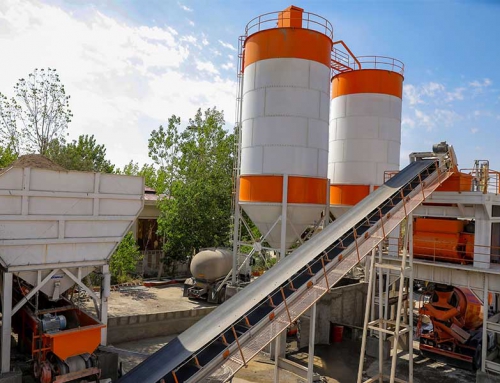The Difference between Ready-Mix Concrete and Site-Mixed Concrete
Concrete is made of three main components which are aggregates, water, and cement, however, the final product can be produced in two ways: Ready-mixed or cite mixed which is produced in factories. Choosing appropriate concrete is vital in construction projects. While both methods can be applied to producing concrete, they vary widely. Stay with us to get a clear idea about the differences between these two products.
What’s the Difference between Ready-Mix Concrete and Site-Mixed Concrete?
There are several factors that cause the final products to be different. These factors include time, equipment, distribution, suggested applications, residue, restoring equipment, labor force, quality, and other vital points. In the following, each method will be introduced separately, and the pros and cons of each one will be discussed.
Ready-Mix Concrete
This method is usually used in concrete manufacturing companies and any supervision over the mixing plan and concrete engineering steps happen at the factory. The project manager has already registered the order for ready-mix concrete and the concrete combination will be transferred to the project construction site by a truck mixer. This type of concrete is usually talked about in terms of square meters and is sold in cubic meters.
![]()
![]()
![]()
![]() Ready-Mix Concrete Features
Ready-Mix Concrete Features
Timing: It’s time-saving and can be soon delivered to the customer.
Distribution: It can be delivered at different sites of a project and its distribution can be easily tracked by construction planning software.
Equipment: There’s no need to concrete production equipment at the construction site.
Storage Conditions: There is no need for any extra space for storing the ingredients at the workshop.
Suggested Application: It fits all urban structures
Waste: The waste of construction materials are at the minimum.
Quality: The quality is high which is due to the controlled and engineered environment.
Labor Force: The labor force is in the factory and to perform the project it is only necessary to vibrate the concrete and flatten the surface which will be done by the workforce.
Space: There should be suitable access for concrete truck mixers.
Concrete meterage: Different amounts of concrete can be delivered at any time of the day or night.
Construction Site Location: If the construction site is too far from the factory, there need to be some additives to the concrete from getting hard.
Advantages of Ready-Mix Concrete
Concrete usually hardens under specific conditions so as to preserve the consistency and consolidation of the high-quality material.
A very small amount of concrete may be wasted at the construction site.
Appropriate mixing and better performance can lessen the cement use percentage.
Concreting speed is very high which is very time-saving.
The concrete mixing project takes place in an engineered, controlled condition.
The result will be a more durable structure and give rise to the life of the building.
Disadvantages of Ready-Mix Concrete
Unexpected traffic- jam while transferring concrete to the construction site may result in using additives.
Transportation time may decrease the efficiency of concrete which is more probable if the factory is far from the construction site.
There might be quality concerns if there in case of a repetitive need for adding additives.
The employer is supposed to pay for the transportation expenses.
Site-Mixed Concrete
The manual or mixed concrete is produced at the construction site and engineers together with the workforce embark upon making this type f concrete using the equipment and construction materials. The process of carrying and processing concrete is done at the construction site and by the labor force.
Site-Mixed Concrete Features
Time: Producing site-mixed concrete is slower and more time-consuming due to several steps and formulas.
Distribution: Site-mixed concrete is used right after production.
Equipment: There needs to be a manual mixer at the construction site.
Restoring Conditions: In order to restore and protect the material such as cement and aggregates, there should be enough space at the construction site.
Suggested Application: It is suitable for small buildings.
Waste: There is a waste of construction materials during the mixing and storing procedures.
Quality: There needs to be constant supervision unless there is no guarantee of what the result will be.
Labor force: Producing concrete at the construction site requires a large workforce.
Space: There needs to be enough space for the manual mixers and restoring the construction materials.
Concrete Meterage:
It is hard to mix a large amount of concrete at the construction site.
Construction site location: Concrete should be carried with a wheelbarrow or other similar vehicles.
Advantages of Mixed Concrete
It is cost-effective for small areas.
There are limitations to its production.
It is produced at the construction site and there is no need to pay for transportation fees.
There are no delays in its arrival and will be used right after production.
Site-Mixed Concrete Disadvantages
There needs to be more space for storing construction materials
There needs to be enough workforce and equipment so that concrete can be performed quickly before it dries out.
There may be a great deal of waste and residue.
There should be close supervision.
It doesn’t have high quality.
In this table, the difference between these two types of concrete is mentioned in-summary.
| Ready-mixed | Site mixed Concrete | |
| Saving time | Fast | Slow |
| Price | Logical for medium to large projects | Logical for small prjects |
| Concreting Speed | High | Low |
| Concrete transportation | has | Doesn’t have |
| Construction Material Storage | has | Doesn’t have |
| Labor Force | needs | Doesn’t need |
| Concrete Quality | Low | High |
Ready mix concrete or Site mix concrete? Final Conclusion
As a general conclusion, Though using site mix concrete comes with an increase in costs, using ready mix concrete is usually a better choice for most construction projects. Ready mix concrete provides the builders with higher quality and saves time.
In ready mix concrete orders, there are no limitations in volume, and you can receive the amount you need very soon and at a high quality.
Important Criteria in Producing High-Quality Concrete
Good ready mix criteria result in a strong foundation for building a firm structure. This includes simplifying the procedure of preparing concrete in which a combination of components produces the necessary durability and resistance for the concrete structure.
Since each of the combination components has its distinct features, ending in an ideal combination is a challenge. To determine the physical features, all components should be examined in advance which is, however, normally ignored.
Fresh concrete mixture is like a chef’s special recipe. Besides the three main components, this artificial substance includes chemical additives too. Therefore, choosing the best concrete mixture is an important task that should not only produce an integrated product but should also take economical aspects into account.
Whether you buy ready mix concrete or the site mix concrete, good combinations should meet these conditions:
1- Water-Cement Ratio
There is a water-to-cement ratio in this mixture in which the relation between the weight of the water and that of the cement defines this ratio. This feature has a direct and linear relationship with concrete pressure resistance and is considered an important factor in concrete mixture plans.
2- Concrete Resistance
Concrete resistance should be examined. Examinations are normally done before processing. All in all, pressure resistance is an important feature in determining the water-cement ratio, aggregate percentage, and other points.
3- Aggregates Siz
All aggregates should be of standard size because they are one of the basic components of any concrete mixture and their physical characteristics such as texture, and shape (Sharp cornered or round-cornered) should be taken into account in the mixture plan.
4- Efficiency
The efficiency of the concrete mixture is a feature that determines the mixture’s capacity for concreting, compactness, and processing. Efficiency is also known as fluidity and workability. Efficiency can be determined with the “Concrete Slump Test”
5- Durability
A good mixture will provide you with concrete that stands intense weather conditions and frequent changes with no signs of failure. The more durable the concrete, The more it stands frequent weather changes like drying out, getting wet, freezing, and getting warm.
6- Compactness
Compactness is one of the most appreciated concrete features in which concrete mixture goes around the rebars and corners of the mold. This is done by vibrating concrete.
Conclusion
In this article, we discussed the difference between ready mix and site mix concrete and described the criteria for producing good concrete. Now you can decide on the type that meets your needs, however, buying ready mix concrete has several advantages. It has superiorities in terms of cost, time, energy, and quality in comparison with site mix concrete.









